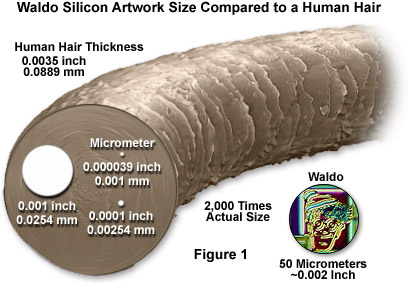The Silicon Zoo
Size DOES Matter
No matter what the rules may be throughout other domains, in the Silicon Zoo, size does matter! How big or small Waldo and all of the other silicon creatures are is often a very good indication of the technological proficiency, power, and speed of the computer chip into which they are stashed. And, as far as electronics is concerned, smaller usually means better. Why else would we buy computers that can fit into the palm of a hand and phones that can easily slip into a shirt pocket?

Of course, there is a better explanation. The reason why a small Waldo generally means big power is that the size of silicon artwork found on computer chips is often a function of contemporary lithography capabilities. Photolithography, a process vital to all integrated circuit fabrication techniques, is similar to printing a photograph by shining light through a negative onto photosensitive material. The result of the process is the generation of miniature transistors that can be found on the surface of a chip, which are usually described in terms of their linear width (termed linewidth). Over the years, the process of photolithography has improved, resulting in the creation of ever smaller transistors. The decrease in transistor linewidth enables a greater number of components (and silicon creatures!) to fit on a single chip, making it faster and more powerful.
In order to put the size issue into a better perspective, let's consider what small really means. The current standard linewidth of some computer chips in production at the high-end fabrication plants is 0.13 micrometers, and a single micrometer is only one-thousandth of a millimeter. Members of the silicon zoo, however, were fabricated over the past 30 years using continuously decreasing linewidths and, therefore, vary in size. Waldo, who first became an elusive comic hero in the 1990s, is a typical example and is approximately 50 micrometers high, only a fraction of the size of a human hair (see Figure 1). The designs on older chips, such as the Star Trek USS Enterprise discovered on a late 1960s or early 1970s integrated circuit, tend to be larger because of thicker linewidths associated with the more primitive technology. Still, even the largest members of the silicon zoo are extremely tiny.
But will there ever be a time when extremely tiny is just too small? According to past patterns and current predictions of the future, the next generation of computer chips, and therefore, future members of the silicon zoo, will be increasingly minuscule. This decrease in size will allow microchips to be used in a number of new and innovative ways. In fact, research has already begun to develop "smart dust," millions of tiny, cheap silicon sensors that could be utilized to monitor large expanses. Needless to say, when microchips successfully achieve such dimensions and capabilities, it will take more firepower than a light microscope (in terms of magnification and resolution) to find the elusive artwork hidden within the circuitry. Without the aid of instruments having better resolution, we will be stuck with our hands in the air asking, "Where's Waldo?"
